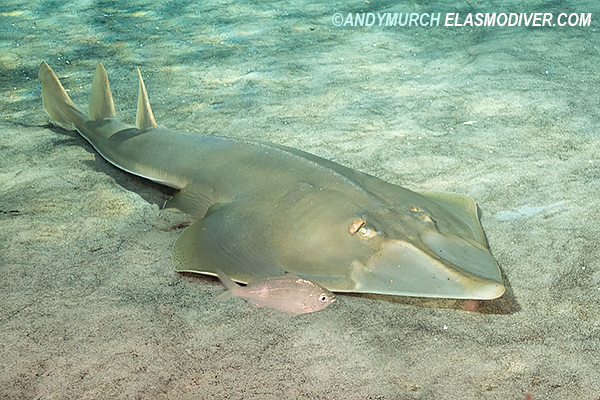|

View all available
Halavi Guitarfish Pictures
Common
English Names:
Halavi guitarfish, halavi ray.
Latin
Name:
Glaucostegus halavi
Family:
Rhinobatidae
Identification:
Dorsum uniformly
tan to greyish brown. Ventrum
pale. A single row of enlarged
tubercles (dermal denticles) run along centre line from back from eyes to tail.
Two very short lines of enlarged denticles positioned midway between spiracles
and trailing edge of pectoral fins. Snout bluntly pointed. Anterior margin
of pectoral fins and snout straight.
Posterior margin of
pectoral fins convex. Two large equally sized dorsal fins with pointed apices
positioned along posterior half of tail. Rostral cartilage thin and somewhat
translucent. Eyes tan colored (matching dorsal coloration). Spiracles roughly
twice as large as eyes. Spiracle have two visible posterior skin folds
(scalloping).
Size:
Maximum
length 120cm.
Habitat:
Sandy bottoms, reefs and sea grass
beds from 0-40m
Abundance
and distribution: Red Sea to Gulf of Oman. Possibly
Gulf of Aden and northwestern Arabian Sea. Sightings from further east (as far
as Southeast Asia) require confirmation. In 2007 an albino Halavi Guitarfish was
reported off the coast of Tunisia confirming the presence of this species in the
Mediterranean. This was likely after migrating through the Suez Canal.
Behavior:
Lays
on sea grass or sand or partially buries in sand when not foraging for food.
Diet:
Feeds on small mollusks and bony fishes.
Reproduction:
Guitarfishes are ovoviviparous (yolk
sac viviparity).
After absorbing all of the yolk,
embryos suckle from tiny club shaped villi (projections) that
provide nutrients for the young as they develop.
Conservation Status:
The IUCN lists the Halavi guitarfish as Data Deficient due to its
unclear range. However, it is a targeted and utilized bycatch in fisheries, but
the amount of catch relative to stock size is not known (Bonfil and Abdallah
2004). Aggregation behavior during spawning may make this species particularly
vulnerable to exploitation.
Off Saudi Arabia, in the Red Sea, artisanal fisheries production is almost
entirely from handline and gillnet methods, while the industrial fleet utilizes
fish and shrimp trawl nets and purse seine nets (FAO 2007). The industrial
vessels operating in the Red Sea utilize trawl nets to target both demersal fish
stocks and shrimp, with the majority of these vessels belong to Saudi Fisheries
Company and operate out of Jizan on the southern Red Sea coast (FAO 2007).
Oman has a long established traditional shark fishery, which has experienced
increased demand in recent years due to the shark fin trade (Henderson et al.
2007). In Omani waters, elasmobranchs are mainly captured by artisanal fishermen
using wooden dhows and fiberglass skiffs with bottom-set longlines, bottom-set
gillnets and driftnets (Henderson et al. 2007). The majority of fishing takes
place in water shallower than 100 m and is therefore confined to inshore areas
(Henderson et al. 2007). The presence of this species in shallow inshore areas
would seem to put them at risk of capture in fisheries, but fishermen in Oman
prefer to focus their fishing efforts in deeper waters where they catch grouper
and other more valuable species (A. Henderson pers. obs. 2007). The fishermen
operating in shallow coastal waters tend to surface-gillnet around reefs, or
cast net for sardines and similar species, so the this species doesn't appear to
be under much pressure in Oman (A. Henderson pers. obs. 2007). It is taken as
incidental bycatch in Oman, and these catches appear to be limited to the Gulf
of Oman (from Musandam in the north, to Muscat) (A. Henderson pers. obs. 2007).
Landings of this species reported in (Henderson et al. 2007) all came from a
single haul, thus artificially elevating the species' importance in the landings
for that region.
Photographs:
Dubai, UAE.
Similar
species: The
halavi guitarfish
shares its range with the sharpnose guitarfish Glaucostegus granulatus which has
a longer, more acutely pointed snout.
Reaction
to divers: Skittish but possible to approach with careful slow movements. May
slowly move away or bolt upon close
examination.
Diving logistics: The halavi guitarfish is
frequently seen by divers in Egypt. It is also a common sight around Musandam in
Northern Oman. Dive shops in those areas should be able to put you in the water
with this species.
Citations and References:
Barnett, L.A.K., Ebert, D.A. & Henderson, A. 2009.
Glaucostegus halavi. The IUCN Red List of Threatened Species. Version
2015.2. <www.iucnredlist.org>.
Ben Souissi, J., Golani, D., Mejri, H., Ben Salem, M. and
Capape, C. 2007. First confirmed record of the Halave's Guitarfish,
Rhinobatos halavi (Forsskal, 1775) (Chondrichthyes: Rhinobatidae) in the
Mediterranean Sea with a description of a case of albinism in elasmobranchs.
Cahiers de Biologie Marine 48(1): 67-75.
|






















